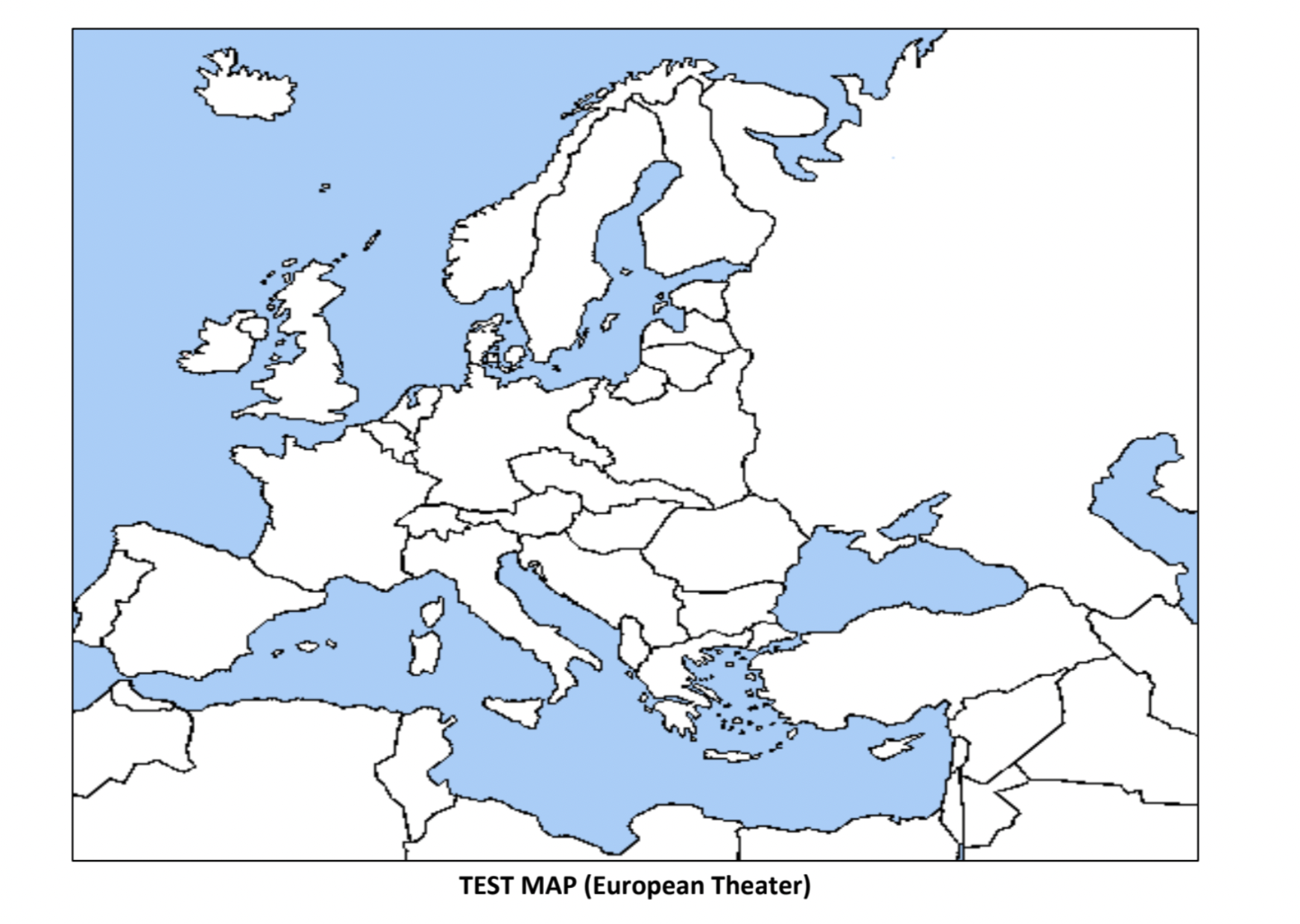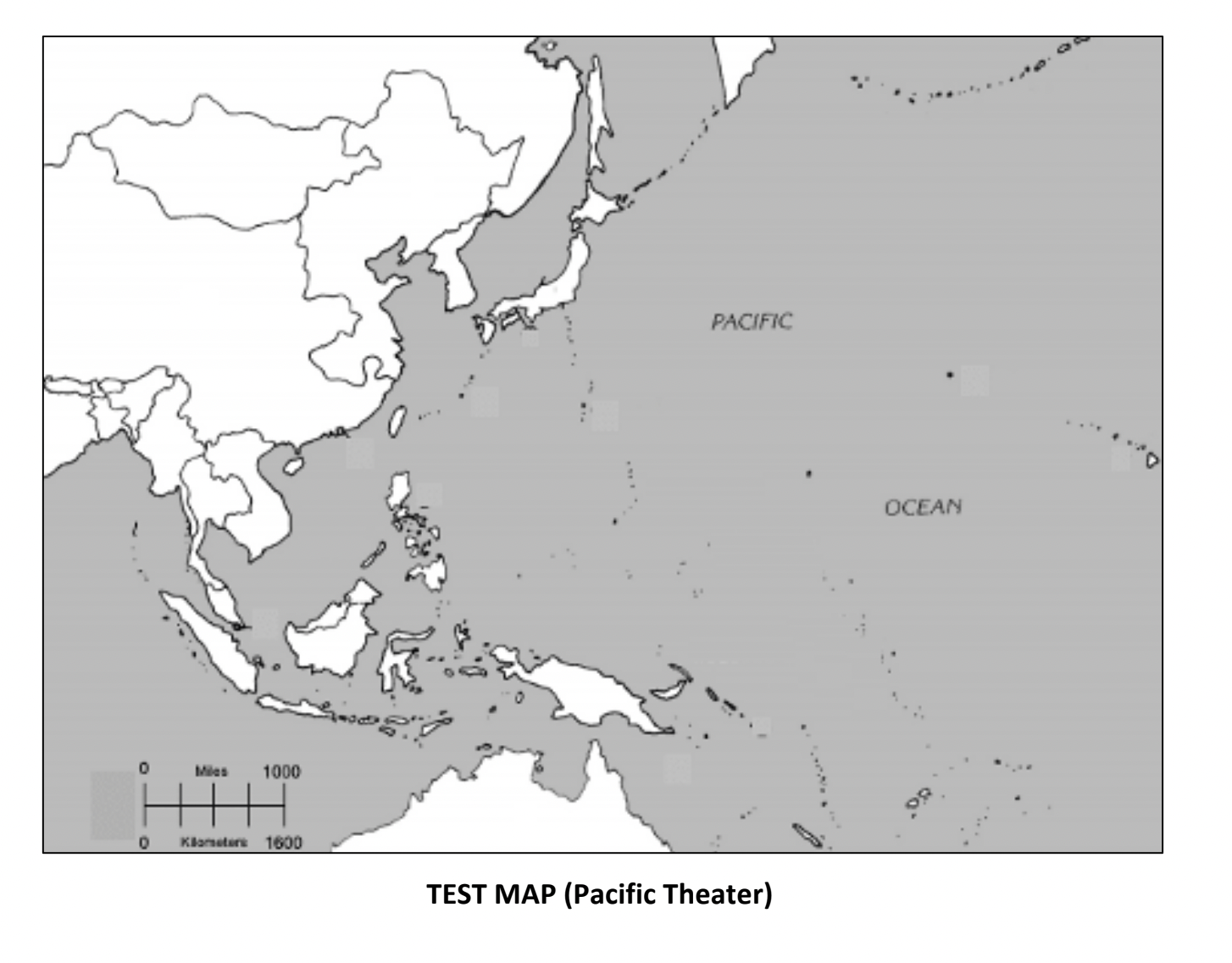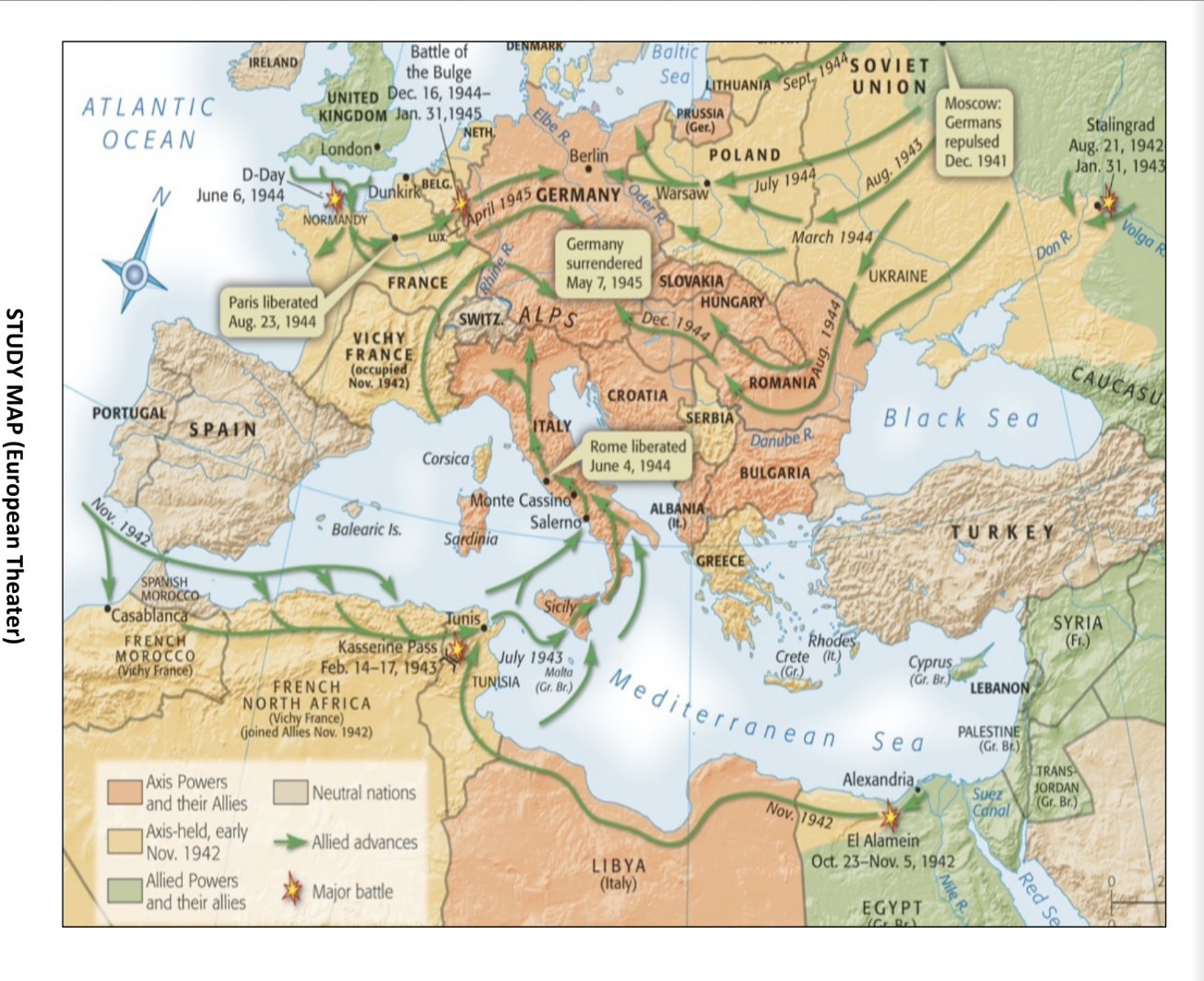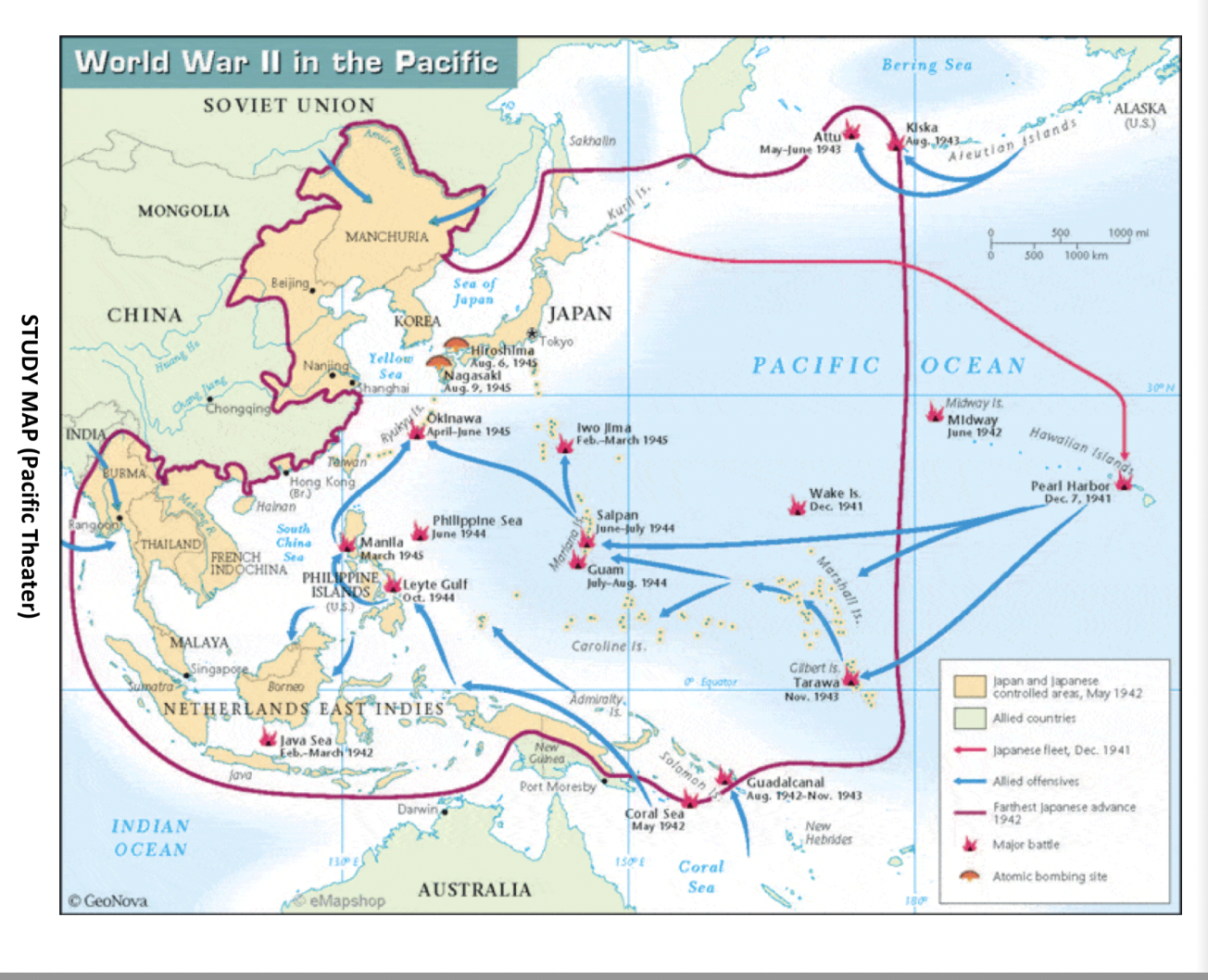
WW2 Map Quiz
Battles / Operations:
Battle of the Atlantic
Who's Involved: Allied naval forces (primarily British and American) vs. German U-boats.
Main Issue: Control of the Atlantic shipping lanes. German U-boats sought to disrupt Allied supply lines by sinking merchant ships.
Other Info: Longest continuous military campaign of World War II, lasting from 1939 to 1945. It involved convoy battles, technological advancements in anti-submarine warfare, and strategic use of intelligence.
Operation Torch
Who's Involved: Allied forces (primarily American) vs. Vichy French and Axis forces in North Africa.
Main Issue: Opening a second front against Axis powers in North Africa, securing Allied control of the Mediterranean.
Other Info: Launched in November 1942, it marked the first major Allied offensive in the European theater. The successful operation laid the groundwork for the Allied invasion of Italy and later the liberation of France.
Battle of Stalingrad
Who's Involved: Soviet Union vs. Nazi Germany.
Main Issue: Control of the city of Stalingrad (now Volgograd) on the Eastern Front. Symbolic and strategic importance for both sides.
Other Info: Fought from August 1942 to February 1943, it was one of the largest and bloodiest battles in history (over 1 million casualties for the USSR). The Soviet victory marked a turning point in the war, halting the German advance into the Soviet Union and initiating the long retreat of the Wehrmacht
Battle of Britain
Who's Involved: Royal Air Force (RAF) vs. Luftwaffe (German Air Force).
Main Issue: Defense of British airspace and cities against German bombing raids, particularly during the Blitz.
Other Info: Fought from July to October 1940, it was the first major military campaign fought entirely by air forces. The RAF's victory prevented a German invasion of Britain and boosted Allied morale.
Battle of the Bulge
Who's Involved: Allied forces (primarily American) vs. German forces.
Main Issue: German counteroffensive in the Ardennes region of Belgium, aiming to split Allied lines and recapture key ports.
Other Info: Fought from December 1944 to January 1945, it was the largest battle fought by the United States Army during World War II. Despite initial German gains, Allied forces repelled the offensive, hastening the end of the war in Europe.
Operation Overlord (D-Day)
Who's Involved: Allied forces (primarily American, British, and Canadian) vs. Nazi Germany.
Main Issue: Amphibious invasion of Normandy, France, to establish a Western Front and liberate German-occupied Western Europe.
Other Info: Launched on June 6, 1944 (D-Day), it involved the largest amphibious assault in history. The successful operation paved the way for the liberation of France and the defeat of Nazi Germany.
Battle of the Coral Sea
Who's Involved: United States vs. Imperial Japanese Navy.
Main Issue: Naval battle fought primarily by aircraft carriers, aiming to halt Japanese expansion in the Pacific and protect Allied supply lines to Australia.
Other Info: Fought in May 1942, it was the first carrier-versus-carrier battle in history and the first naval battle where opposing ships never sighted each other. It resulted in strategic setbacks for both sides but prevented a Japanese invasion of Port Moresby.
Battle of Midway
Who's Involved: United States vs. Imperial Japanese Navy.
Main Issue: Naval battle fought near Midway Atoll, aiming to halt Japanese expansion in the Pacific and destroy their aircraft carriers.
Other Info: Fought in June 1942, it was a decisive American victory, sinking four Japanese aircraft carriers and turning the tide of the Pacific War in favor of the Allies.
Battle of Guadalcanal
Who's Involved: United States vs. Imperial Japanese Army and Navy.
Main Issue: Control of Guadalcanal in the Solomon Islands, a strategic location for both sides in the Pacific theater.
Other Info: Fought from August 1942 to February 1943, it was the first major offensive by Allied forces against Japan. The battle involved intense fighting on land, at sea, and in the air and marked a significant turning point in the Pacific War.
Key Places:
Casablanca
Allied conference held in Casablanca, Morocco, in January 1943.
Attendees included Roosevelt, Churchill, and high-ranking military officials.
Main outcomes:
Affirmation of the policy of demanding unconditional surrender from Axis powers.
Strategic decisions made for the remainder of the war, including the invasion of Sicily.
Sicily
Allied invasion of Sicily, codenamed Operation Husky, in July 1943.
Involved American, British, and Canadian forces.
Main objectives:
Gain a foothold in Italy and remove Mussolini from power.
Divert Axis attention from the Eastern Front.
Led to the downfall of Mussolini's fascist regime and set the stage for the Italian Campaign.
Tehran
Conference held in Tehran, Iran, in November 1943.
Attended by Roosevelt, Churchill, and Stalin.
Main outcomes:
Agreement on launching Operation Overlord (D-Day) and coordinating military strategy.
Discussion on post-war reorganization, including the division of Germany and the formation of the United Nations.
Philippine Islands
Key battleground in the Pacific Theater during World War II.
Subject to Japanese occupation after the attack on Pearl Harbor.
Main events:
Battles of the Philippine Sea and Leyte Gulf secured Allied control of the region.
General Douglas MacArthur fulfilled his promise to return to the Philippines, leading to the liberation of the islands.
Pearl Harbor
Surprise military strike by the Imperial Japanese Navy on the United States naval base at Pearl Harbor, Hawaii, on December 7, 1941.
Resulted in the sinking of several American ships and the deaths of thousands of military personnel and civilians.
Prompted the United States to enter World War II, declaring war on Japan the following day.
Saipan
Battle for the island of Saipan in the Mariana Islands in June-July 1944.
Fought between American and Japanese forces.
Significance:
Secured a strategic base for American bombers within range of the Japanese home islands.
Witnessed mass civilian suicides by Japanese civilians fearing American occupation.
Iwo Jima
Fierce battle fought between American Marines and entrenched Japanese defenders in February-March 1945.
Objective was to capture the island's airfields for use in the planned invasion of Japan.
Iconic image of U.S. Marines raising the American flag atop Mount Suribachi.
Okinawa
Largest amphibious assault in the Pacific Theater, conducted by Allied forces in April-June 1945.
Intense battle against entrenched Japanese defenders.
Significant casualties on both sides and widespread civilian suffering.
Provided a staging area for the planned invasion of Japan before the atomic bombings.
Manchuria & China
Japanese invasion and occupation of Manchuria and various parts of China before and during World War II.
Brutal tactics employed against both military and civilian populations.
Contributed to the overall dynamics of the Pacific Theater and the broader war in Asia.
Tokyo
Intensive firebombing raids conducted by Allied forces, particularly the United States Army Air Forces, against Tokyo and other Japanese cities.
Aimed at crippling Japanese industry and morale.
Resulted in widespread destruction and loss of life, setting the stage for the use of atomic bombs.
Hiroshima
First wartime use of nuclear weapons.
Atomic bomb dropped by the United States on Hiroshima on August 6, 1945.
Resulted in immediate and catastrophic devastation, with tens of thousands killed instantly and many more dying later from radiation sickness.
Nagasaki
Second atomic bomb dropped by the United States on Nagasaki on August 9, 1945.
Further demonstrated the destructive power of nuclear weapons.
Led to Japan's surrender and the end of World War II.
Potsdam
Conference held in Potsdam, Germany, in July-August 1945.
Attended by Truman, Churchill (later replaced by Attlee), and Stalin.
Discussed post-war arrangements and issued the Potsdam Declaration calling for Japan's unconditional surrender.
Austria
Liberated from Nazi rule by Allied forces in 1945.
Divided into occupation zones by the victorious Allied powers.
Contributed to the reorganization of Europe and the defeat of Nazi Germany.
Poland
Invaded by Nazi Germany on September 1, 1939, marking the beginning of World War II in Europe.
Subject to brutal occupation and genocide by the Nazis.
Symbolized the failure of appeasement policies and led to the eventual defeat of Nazi Germany.
Czechoslovakia
Annexed by Nazi Germany in March 1939 following the Munich Agreement.
Further dismembered by Germany and Hungary.
Exemplified the policy of appeasement and highlighted Hitler's aggressive expansionism, leading to the outbreak of World War II.
Misc:
Axis Powers
Germany:
Led by Adolf Hitler and the Nazi Party.
Axis invasion of Poland in September 1939 triggered the outbreak of World War II in Europe.
Pursued a policy of aggressive expansionism, aiming for the creation of a "Greater Germany" and domination of Europe.
Involved in major campaigns such as the Blitzkrieg in Western Europe, Operation Barbarossa against the Soviet Union, and the North African campaign.
Italy:
Led by Benito Mussolini and the Fascist Party.
Involved in the invasion of Ethiopia, the Spanish Civil War, and the Balkans Campaign.
Joined the Axis Powers officially in 1940.
Suffered significant military defeats in North Africa and the Italian Campaign.
Japan:
Led by Emperor Hirohito and the militaristic government.
Expansionist policies led to the invasion of Manchuria in 1931 and subsequent conflicts in China.
Attacked Pearl Harbor in December 1941, bringing the United States into the war.
Fought in the Pacific Theater against Allied forces, with major battles including Midway, Guadalcanal, and Okinawa.
Allied Powers
United States:
Led by President Franklin D. Roosevelt.
Entered the war after the attack on Pearl Harbor in December 1941.
Played a major role in the Allied victory, providing significant military and industrial resources.
Fought in both the European and Pacific Theaters, including major campaigns such as D-Day, the Battle of Midway, and the island-hopping campaign in the Pacific.
United Kingdom:
Led by Prime Minister Winston Churchill.
Fought against Nazi Germany in Europe from the outset of the war.
Played a crucial role in the Battle of Britain and subsequent campaigns in North Africa and Italy.
Maintained a global empire and coordinated with Allied forces across various theaters of war.
Soviet Union:
Led by Joseph Stalin.
Signed the Molotov-Ribbentrop Pact with Germany in 1939, but later invaded by Nazi forces in Operation Barbarossa.
Engaged in brutal warfare on the Eastern Front, with key battles including Stalingrad and Kursk.
Contributed significantly to the defeat of Nazi Germany with massive manpower and resources.
China:
Led by Chiang Kai-shek and the Nationalist government.
Fought against Japanese aggression since the 1930s.
Suffered heavily from Japanese invasion and occupation but tied down significant Japanese forces in China.




WW2 Map Quiz
Battles / Operations:
Battle of the Atlantic
Who's Involved: Allied naval forces (primarily British and American) vs. German U-boats.
Main Issue: Control of the Atlantic shipping lanes. German U-boats sought to disrupt Allied supply lines by sinking merchant ships.
Other Info: Longest continuous military campaign of World War II, lasting from 1939 to 1945. It involved convoy battles, technological advancements in anti-submarine warfare, and strategic use of intelligence.
Operation Torch
Who's Involved: Allied forces (primarily American) vs. Vichy French and Axis forces in North Africa.
Main Issue: Opening a second front against Axis powers in North Africa, securing Allied control of the Mediterranean.
Other Info: Launched in November 1942, it marked the first major Allied offensive in the European theater. The successful operation laid the groundwork for the Allied invasion of Italy and later the liberation of France.
Battle of Stalingrad
Who's Involved: Soviet Union vs. Nazi Germany.
Main Issue: Control of the city of Stalingrad (now Volgograd) on the Eastern Front. Symbolic and strategic importance for both sides.
Other Info: Fought from August 1942 to February 1943, it was one of the largest and bloodiest battles in history (over 1 million casualties for the USSR). The Soviet victory marked a turning point in the war, halting the German advance into the Soviet Union and initiating the long retreat of the Wehrmacht
Battle of Britain
Who's Involved: Royal Air Force (RAF) vs. Luftwaffe (German Air Force).
Main Issue: Defense of British airspace and cities against German bombing raids, particularly during the Blitz.
Other Info: Fought from July to October 1940, it was the first major military campaign fought entirely by air forces. The RAF's victory prevented a German invasion of Britain and boosted Allied morale.
Battle of the Bulge
Who's Involved: Allied forces (primarily American) vs. German forces.
Main Issue: German counteroffensive in the Ardennes region of Belgium, aiming to split Allied lines and recapture key ports.
Other Info: Fought from December 1944 to January 1945, it was the largest battle fought by the United States Army during World War II. Despite initial German gains, Allied forces repelled the offensive, hastening the end of the war in Europe.
Operation Overlord (D-Day)
Who's Involved: Allied forces (primarily American, British, and Canadian) vs. Nazi Germany.
Main Issue: Amphibious invasion of Normandy, France, to establish a Western Front and liberate German-occupied Western Europe.
Other Info: Launched on June 6, 1944 (D-Day), it involved the largest amphibious assault in history. The successful operation paved the way for the liberation of France and the defeat of Nazi Germany.
Battle of the Coral Sea
Who's Involved: United States vs. Imperial Japanese Navy.
Main Issue: Naval battle fought primarily by aircraft carriers, aiming to halt Japanese expansion in the Pacific and protect Allied supply lines to Australia.
Other Info: Fought in May 1942, it was the first carrier-versus-carrier battle in history and the first naval battle where opposing ships never sighted each other. It resulted in strategic setbacks for both sides but prevented a Japanese invasion of Port Moresby.
Battle of Midway
Who's Involved: United States vs. Imperial Japanese Navy.
Main Issue: Naval battle fought near Midway Atoll, aiming to halt Japanese expansion in the Pacific and destroy their aircraft carriers.
Other Info: Fought in June 1942, it was a decisive American victory, sinking four Japanese aircraft carriers and turning the tide of the Pacific War in favor of the Allies.
Battle of Guadalcanal
Who's Involved: United States vs. Imperial Japanese Army and Navy.
Main Issue: Control of Guadalcanal in the Solomon Islands, a strategic location for both sides in the Pacific theater.
Other Info: Fought from August 1942 to February 1943, it was the first major offensive by Allied forces against Japan. The battle involved intense fighting on land, at sea, and in the air and marked a significant turning point in the Pacific War.
Key Places:
Casablanca
Allied conference held in Casablanca, Morocco, in January 1943.
Attendees included Roosevelt, Churchill, and high-ranking military officials.
Main outcomes:
Affirmation of the policy of demanding unconditional surrender from Axis powers.
Strategic decisions made for the remainder of the war, including the invasion of Sicily.
Sicily
Allied invasion of Sicily, codenamed Operation Husky, in July 1943.
Involved American, British, and Canadian forces.
Main objectives:
Gain a foothold in Italy and remove Mussolini from power.
Divert Axis attention from the Eastern Front.
Led to the downfall of Mussolini's fascist regime and set the stage for the Italian Campaign.
Tehran
Conference held in Tehran, Iran, in November 1943.
Attended by Roosevelt, Churchill, and Stalin.
Main outcomes:
Agreement on launching Operation Overlord (D-Day) and coordinating military strategy.
Discussion on post-war reorganization, including the division of Germany and the formation of the United Nations.
Philippine Islands
Key battleground in the Pacific Theater during World War II.
Subject to Japanese occupation after the attack on Pearl Harbor.
Main events:
Battles of the Philippine Sea and Leyte Gulf secured Allied control of the region.
General Douglas MacArthur fulfilled his promise to return to the Philippines, leading to the liberation of the islands.
Pearl Harbor
Surprise military strike by the Imperial Japanese Navy on the United States naval base at Pearl Harbor, Hawaii, on December 7, 1941.
Resulted in the sinking of several American ships and the deaths of thousands of military personnel and civilians.
Prompted the United States to enter World War II, declaring war on Japan the following day.
Saipan
Battle for the island of Saipan in the Mariana Islands in June-July 1944.
Fought between American and Japanese forces.
Significance:
Secured a strategic base for American bombers within range of the Japanese home islands.
Witnessed mass civilian suicides by Japanese civilians fearing American occupation.
Iwo Jima
Fierce battle fought between American Marines and entrenched Japanese defenders in February-March 1945.
Objective was to capture the island's airfields for use in the planned invasion of Japan.
Iconic image of U.S. Marines raising the American flag atop Mount Suribachi.
Okinawa
Largest amphibious assault in the Pacific Theater, conducted by Allied forces in April-June 1945.
Intense battle against entrenched Japanese defenders.
Significant casualties on both sides and widespread civilian suffering.
Provided a staging area for the planned invasion of Japan before the atomic bombings.
Manchuria & China
Japanese invasion and occupation of Manchuria and various parts of China before and during World War II.
Brutal tactics employed against both military and civilian populations.
Contributed to the overall dynamics of the Pacific Theater and the broader war in Asia.
Tokyo
Intensive firebombing raids conducted by Allied forces, particularly the United States Army Air Forces, against Tokyo and other Japanese cities.
Aimed at crippling Japanese industry and morale.
Resulted in widespread destruction and loss of life, setting the stage for the use of atomic bombs.
Hiroshima
First wartime use of nuclear weapons.
Atomic bomb dropped by the United States on Hiroshima on August 6, 1945.
Resulted in immediate and catastrophic devastation, with tens of thousands killed instantly and many more dying later from radiation sickness.
Nagasaki
Second atomic bomb dropped by the United States on Nagasaki on August 9, 1945.
Further demonstrated the destructive power of nuclear weapons.
Led to Japan's surrender and the end of World War II.
Potsdam
Conference held in Potsdam, Germany, in July-August 1945.
Attended by Truman, Churchill (later replaced by Attlee), and Stalin.
Discussed post-war arrangements and issued the Potsdam Declaration calling for Japan's unconditional surrender.
Austria
Liberated from Nazi rule by Allied forces in 1945.
Divided into occupation zones by the victorious Allied powers.
Contributed to the reorganization of Europe and the defeat of Nazi Germany.
Poland
Invaded by Nazi Germany on September 1, 1939, marking the beginning of World War II in Europe.
Subject to brutal occupation and genocide by the Nazis.
Symbolized the failure of appeasement policies and led to the eventual defeat of Nazi Germany.
Czechoslovakia
Annexed by Nazi Germany in March 1939 following the Munich Agreement.
Further dismembered by Germany and Hungary.
Exemplified the policy of appeasement and highlighted Hitler's aggressive expansionism, leading to the outbreak of World War II.
Misc:
Axis Powers
Germany:
Led by Adolf Hitler and the Nazi Party.
Axis invasion of Poland in September 1939 triggered the outbreak of World War II in Europe.
Pursued a policy of aggressive expansionism, aiming for the creation of a "Greater Germany" and domination of Europe.
Involved in major campaigns such as the Blitzkrieg in Western Europe, Operation Barbarossa against the Soviet Union, and the North African campaign.
Italy:
Led by Benito Mussolini and the Fascist Party.
Involved in the invasion of Ethiopia, the Spanish Civil War, and the Balkans Campaign.
Joined the Axis Powers officially in 1940.
Suffered significant military defeats in North Africa and the Italian Campaign.
Japan:
Led by Emperor Hirohito and the militaristic government.
Expansionist policies led to the invasion of Manchuria in 1931 and subsequent conflicts in China.
Attacked Pearl Harbor in December 1941, bringing the United States into the war.
Fought in the Pacific Theater against Allied forces, with major battles including Midway, Guadalcanal, and Okinawa.
Allied Powers
United States:
Led by President Franklin D. Roosevelt.
Entered the war after the attack on Pearl Harbor in December 1941.
Played a major role in the Allied victory, providing significant military and industrial resources.
Fought in both the European and Pacific Theaters, including major campaigns such as D-Day, the Battle of Midway, and the island-hopping campaign in the Pacific.
United Kingdom:
Led by Prime Minister Winston Churchill.
Fought against Nazi Germany in Europe from the outset of the war.
Played a crucial role in the Battle of Britain and subsequent campaigns in North Africa and Italy.
Maintained a global empire and coordinated with Allied forces across various theaters of war.
Soviet Union:
Led by Joseph Stalin.
Signed the Molotov-Ribbentrop Pact with Germany in 1939, but later invaded by Nazi forces in Operation Barbarossa.
Engaged in brutal warfare on the Eastern Front, with key battles including Stalingrad and Kursk.
Contributed significantly to the defeat of Nazi Germany with massive manpower and resources.
China:
Led by Chiang Kai-shek and the Nationalist government.
Fought against Japanese aggression since the 1930s.
Suffered heavily from Japanese invasion and occupation but tied down significant Japanese forces in China.




 Knowt
Knowt